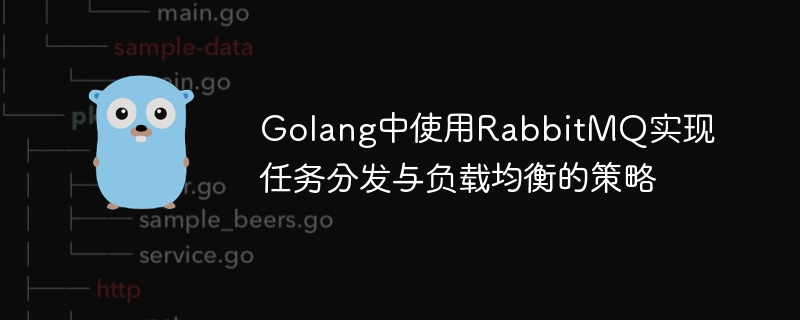

Strategy for using RabbitMQ to achieve task distribution and load balancing in Golang
Overview:
In a distributed system, task distribution and load balancing are very important of. A common solution is to use message queues to implement task distribution and processing. This article will introduce how to use Golang and RabbitMQ to implement task distribution and load balancing strategies, and provide specific code examples.
Introduction to RabbitMQ:
RabbitMQ is a reliable, scalable, open source message middleware that uses the AMQP (Advanced Message Queuing Protocol) protocol for message delivery. The core concepts of RabbitMQ are producers, consumers and queues. Producers send messages to the queue, and consumers get messages from the queue for processing.
RabbitMQ package in Golang:
There is a package called "streadway/amqp" in Golang that can use RabbitMQ. We can use this package to connect to the RabbitMQ server, create channels, declare queues, send messages, receive messages and other operations.
Task distribution and load balancing strategy:
In our scenario, there are multiple tasks that need to be processed, and we want to distribute these tasks to multiple processing nodes for processing. In order to achieve load balancing, we can adopt the Round-Robin strategy, that is, each processing node obtains a task for processing in turn. When a task is processed, the processing node will send a confirmation message to the RabbitMQ server to inform that the task has been completed, and then continue to obtain the next task.
Code sample:
The following is a simple sample code that demonstrates how to use Golang and RabbitMQ to implement task distribution and load balancing strategies.
First, we need to install RabbitMQ and make sure the RabbitMQ server is started.
package main
import (
"log"
"os"
"strings"
"github.com/streadway/amqp"
)
func failOnError(err error, msg string) {
if err != nil {
log.Fatalf("%s: %s", msg, err)
}
}
func main() {
conn, err := amqp.Dial("amqp://guest:guest@localhost:5672/") // 连接RabbitMQ服务器
failOnError(err, "Failed to connect to RabbitMQ")
defer conn.Close()
ch, err := conn.Channel() // 创建通道
failOnError(err, "Failed to open a channel")
defer ch.Close()
q, err := ch.QueueDeclare(
"task_queue", // 队列名称
true, // 队列是否持久化
false, // 队列是否自动删除
false, // 是否具有排他性
false, // 是否等待服务器响应
nil, // 额外参数
)
failOnError(err, "Failed to declare a queue")
err = ch.Qos(
1, // 消费者每次从队列中获取一个任务进行处理
0, // 预取计数,0表示不限制预取数量
false, // 是否应用于整个连接,false表示只应用于当前通道
)
failOnError(err, "Failed to set QoS")
msgs, err := ch.Consume(
q.Name, // 队列名称
"", // 消费者标签,用于区分不同的消费者
false, // 是否应用于整个连接,false表示只应用于当前通道
false, // 是否使用服务器自动生成的唯一标识符
false, // 是否需要等待服务器响应
false, // 是否排他性,如果设置true,则只有当前连接可以访问该队列
nil, // 额外参数
)
failOnError(err, "Failed to register a consumer")
forever := make(chan bool)
go func() {
for d := range msgs {
log.Printf("Received a message: %s", d.Body)
task := string(d.Body)
// 模拟任务的处理过程
err := processTask(task)
if err != nil {
log.Printf("Failed to process task: %s", err)
d.Reject(false) //任务处理失败,重新放回队列
} else {
log.Printf("Task processed successfully")
d.Ack(false) // 任务处理成功,发送确认消息
}
}
}()
log.Printf("Waiting for tasks. To exit press CTRL+C")
<-forever
}
func processTask(task string) error {
// 实际的任务处理逻辑
return nil
}The above code implements a consumer that processes tasks by obtaining tasks from the queue in the RabbitMQ server. In this example, we name the queue "task_queue" and set its persistence to true. After the consumer obtains the task, it will call the processTask function to process the task, and then send a confirmation message to the RabbitMQ server.
Summary:
This article introduces how to use Golang and RabbitMQ to implement task distribution and load balancing strategies. By using RabbitMQ's message queue mechanism, we can achieve automatic distribution and load balancing of tasks, improving the scalability and reliability of the system. Hope this article can be helpful to readers.
The above is the detailed content of Strategies for using RabbitMQ to achieve task distribution and load balancing in Golang. For more information, please follow other related articles on the PHP Chinese website!
 How to define variables in golang
How to define variables in golang
 What are the data conversion methods in golang?
What are the data conversion methods in golang?
 What is the difference between rabbitmq and kafka
What is the difference between rabbitmq and kafka
 What are the commonly used libraries in golang?
What are the commonly used libraries in golang?
 What is the difference between golang and python
What is the difference between golang and python
 Disk scheduling algorithm
Disk scheduling algorithm
 What are the methods for restarting applications in Android?
What are the methods for restarting applications in Android?
 What are the java file transfer methods?
What are the java file transfer methods?




